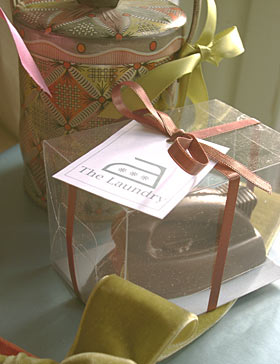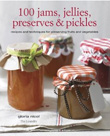FESTIVE JAM FROM FAR FLUNG PLACES
Monday December 19th 2011, 9:57 am
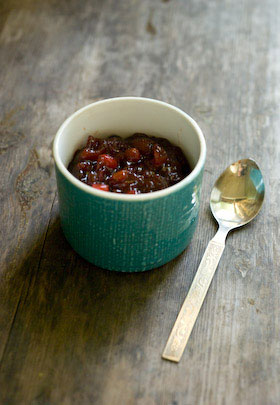
I prefer to use the ingredients I find on my doorstep, but sometimes occasion decrees it’s time to push the boat out. I’d love to find homegrown cranberries but have never seen them for sale on my travels, though Sainsburys are selling Kent grown cranberries this year, but only available in that area. So for my special Christmas jam, my cranberries are from the US, dried apricots from Turkey and pineapple from Costa Rica. I hope all you locavores will forgive me! For some of you lucky enough, these ingredients will be on your doorstep.
I saw mention of this combination in an old book of mine and thought it worth exploring. In that recipe the pineapple came in a tin and for my first experiment I used a tin of crushed pineapple in natural juice. Having noticed fresh pineapples not much different in price to tinned, I decided to use fresh for my second batch. Both work well with perhaps the fresh having just that added zing you might expect. The final flourish – apricot brandy, just makes this fabulous jam extra special, befitting the season.
The fruits cook down to a ‘feltly’ consistency, which from my experience means you need to watch it doesn’t catch on the bottom of the pan and burn. So don’t leave the bubbling jam kettle for even a minute or your jam may be spoilt. My recipe calls for relatively little sugar. This does mean that it is advisable to store the preserve in the fridge or the ideal alternative, do like I do and can it. That way it will store for a year or even longer. Serve on toast, scones or with your celebration meal as a relish. I’m off to make some more.
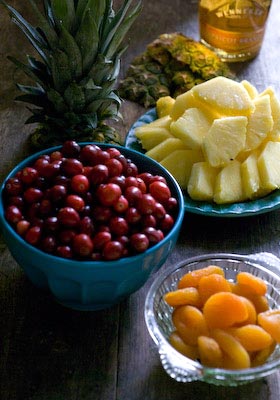
CRANBERRY, APRICOT AND PINEAPPLE JAM
Makes 1.3Kg (5 x 1/2pt jars)
1 med size pineapple, approx 1100g (2 1/2lbs) in weight or a 432g (15oz) tin crushed pineapple in juice
150g (5oz) dried apricots
300g (1x 12oz pack) fresh cranberries, rinsed and drained
450g (1lb) sugar
apricot brandy (optional)
Prepare the pineapple; slice off the top and base and pare away the skin. Chop down through the centre lengthways and cut into 4, then remove the woody core. Slice the flesh into chunks then pulse in a food processor to give a fine texture. Pour into a sieve over a bowl and collect the juice that drips through. With my 1100g pineapple, this gave me 280g (10oz) pulp and 200ml (7 fl oz) of juice. (You don’t need to be spot on here just aim for approximately that amount.) Chop the apricots into small even pieces and place in a bowl with 200ml (7 fl oz) of boiling water plus the pineapple juice and leave to soak for several hours or overnight.
If you plan to can (water process) your jam, prepare the water bath and jars and place jar seals in a pan of hot water on the hob. Alternatively, prepare clean jars by sterilising them in a low oven, keeping them warm till needed. Place the cranberries, apricots, crushed pineapple and soaking juices in a preserving pan. Add another 200ml (7 fl oz) water and cook gently for approximately 20 minutes, until the cranberries have started to pop and the mixture combines and takes on a ruby glow. Remove from heat for 5 minutes then add the sugar. Stir over a gentle heat until completely dissolved, then up the heat and bring to a rolling boil, taking great care that it doesn’t burn. It only takes 5-10 minutes before you can see the texture is thickened and a small blob on a cold plate will hold its shape. Turn off the heat. Leave for 5 minutes then stir in 3-5 Tbsp apricot brandy.
Pour into prepared hot jars leaving 0.5cm (1/4in) headroom, tap jars on worktop to de-bubble, clean rims and seal, then process for 10 minutes. Remove jars from water bath and leave until completely cold before testing the seals. Alternatively, pot the hot jam into clean hot jars and seal then store in the fridge when cold.
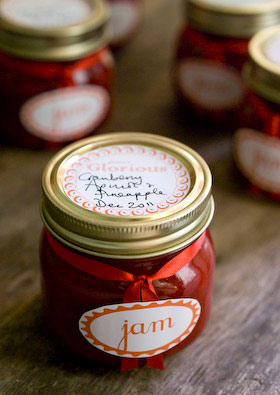
Happy Holiday
Saturday December 17th 2011, 9:41 am

Apologies for my long absence. I’ve been reassessing how I allocate my time! That and my Mum being ill has given me a lot to think about. That doesn’t mean I haven’t been busy though. Once you have been following the seasons with ingredients, watching, anticipating, harvesting, canning and preserving for a while, it becomes second nature, the way that you live and a direct and real connection to the food you eat. I’ve become particularly aware of this by being displaced due to my Mum being ill. I have by necessity been spending time away from my home and my patch, the place I have been observing and making use of so intensely for the last few years. It just meant I’ve had to find new connections in a city I left 30 years ago.
Yesterday it was time to rustle up my Christmas wreath. The wreath base has been used on previous occasions and is a favourite; washed and weathered, looseley twisted vine that comes already wrapped with some tatty raffia from a previous incarnation, perfect. I wanted my wreath to be a celebration of what nature has handed me in 2011 and would have searched for a few remaining sloes on branches or scavenged some crab apples of a neighbours tree, but I didn’t want it to turn into a performance. So I just went around the garden looking and snipping and then very simply pushed stems through between the twisted vine base. I used some lengths of straggling clematis that the cold had turned dark crimson, some plump orange-red rosehips, sprigs of bay; the fresh growth tips of bay trees branches, hypericum with black fruits set amongst stunning red tinted leaves and finally some unripe blackberries that found themselves double-crossed by deceiving weather conditions. You don’t need much for it to work. My tip if you are new to this sort of thing and want to have a go, is to use your foliage in 3’s, to give a loosley structured and organic result odd numbers work best.
I hope that you enjoy the holiday season ahead, whatever it means to you and look forward to starting afresh in 2012. In such uncertain times one thing shouts out to me loud and clear – CANNING IS THE WAY TO GO! Just saying. Have a good one.
GOT MY HEAD STUCK IN A RUMTOPF
Tuesday July 13th 2010, 9:57 pm
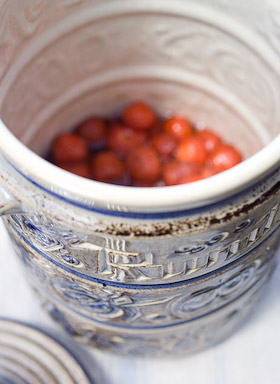
Tigress got the ball rolling back in June when she wrote about her plans to start a rumtopf using her new-fandagly fermenting crock. I don’t think I’m the only one she inspired to rumtopf-along with her, but first I needed a suitable jar. The only pots I’ve seen for making rumtopf have always struck me as hideous; big bulbous lumpy jars illustrated with fruits and the word ‘rumtopf’ etched on the front, the recipe is right there on the jar. A fermenting crock would be a very cool to use, but as they are hard to find and when found cost in the region of £80, one of them was way out of my league. I kept my eye on Ebay and eventually found a jar that I could live with. You can make do with a tall clip-top preserving jar instead if you like but I’m enjoying making my rumtopf in its own purpose designed container.
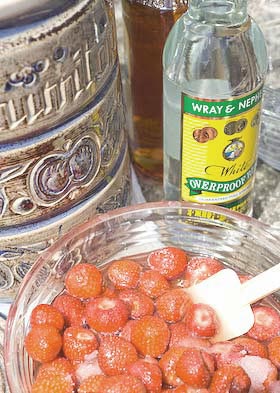
So the jar eventually arrived and it is definitely vintage 70’s. I peered inside and caught a glorious wiff. The jar was not only vintage but had been used before. I knew this as the lightly crazed inside had soaked up previous alcohol and fruit flavours. It smelt fabulous, fruity spirit with a hint of lovage! I couldn’t stop sniffing and shoving my head further inside to soak up the aroma. The jar is about head size, you could effortlessly slip your head inside whilst becoming mesmerised by this magical scent and the desire for more, but slipping it out again may not have been quite so easy. I stopped short of ending up in casualty with a rumtopf on my head. That would have been ridiculous but, come to think of it, would have ensured a mention in the Forest Review.
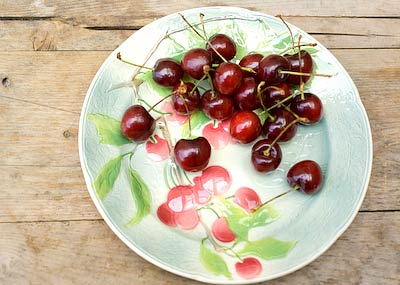
So what is a rumtopf? It is a way of preserving fruit in alcohol. You start it June – July time, add different fruits in layers as they come into season, throughout the summer and autumn, along with some sugar and enough rum or brandy to keep it submerged, and when it is full, about 6 – 8 weeks before Christmas, you then leave it till ready to devour at Christmas time. The contents can be decanted into kilner jars to give as gifts, the fruit can be eaten with cream or ice cream and the alcohol, which I understand is deceivingly dangerous, can be drunk as a liqueur or added to sparkling wine.
Most fruits are suitable with just a few exceptions; melon is too watery, the skins of blueberries and gooseberries go hard, bananas turn to mush, citrus fruits and rhubarb are a no-no. Traditionally you start with the first strawberries of the year, any amount between 250g – 750g plus half its weight in sugar. Remove the stalks and leave the fruit and sugar in a glass dish to marinate overnight and help release the juices before decanting it into the rumtopf jar. Pour rum or brandy over it until it is completely submerged, then find a plate or saucer that will fit inside the jar and push it under the alcohol so that the fruit can’t bob up to the top. I have read that the alcohol should be at least 54% proof and as spirits on general sale are usually around the 40% mark I had to seek out some overproof stuff. Asda sells an overproof white rum at 63%, so I mixed it, two thirds overproof to one third normal dark rum to get somewhere near the 54%, make the rum go further and give it a darker colour. I think this may be a mere detail and am sure that most people don’t go to so much trouble.
You continue to add more fruity layers as they appear; raspberries, cherries, nectarines, peaches, pears, plums, apricots and blackberries. Use any amount of fruit you have, adding half its weight in sugar each time and making sure to add more alcohol when needed to keep it covered. Cover the top of the jar with clingfilm and put the lid on top of that then leave it in a cool place out of the way to do its thing. If using a clear glass preserving jar, keep in a dark place as well. I’m up to my third layer of fruit so far but just can’t stop myself having a sniff everytime I walk by the jar.
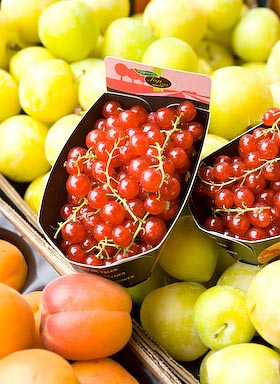
BAKE EARLY FOR CHRISTMAS
Tuesday November 11th 2008, 3:56 pm
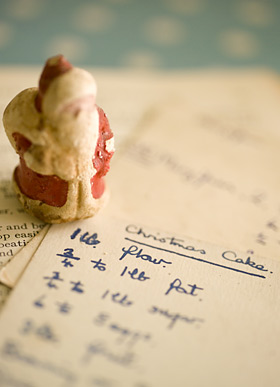
It is time to think about baking the Christmas cake. I’d like to say that I have an old family recipe passed down through the generations, but I haven’t and as I don’t bake a cake every year either, I have generally forgotten which recipe I followed the previous time. Delia is always reliable, I’m sure I’ve made hers on several occasions.
Last year my neighbour, John, decided he’d make a cake for each of his two daughters and was given several recipes by various people. He ended up making three cakes following three different recipes, not knowing which recipe would be the best. We discovered that if you bake your cake in a square or rectangular tin, as opposed to a round tin, you can then sample the cakes by slicing off one of the sides, which would eventually be covered in almond paste and icing anyway. For several weeks we had cake tastings in the afternoon, comparing the different cakes, deciding whether we preferred a recipe which had treacle in it or another one that included cocoa. Of course the more tastings we had, the smaller the cakes became. ‘Shall I just cut another slice off the other side?’, he’d say, ‘ yes why not’, I’d reply.
What was so great about these cake tastings was that it became much easier to recognise what an ideal Christmas cake should contain when there were others to compare against. This isn’t something we often get the opportunity to do, unless we work in the Good Housekeeping Institute. I realised that I’m not so keen on treacle in the mix as I think it gives a bitter taste.
Now the time has come round again to think about baking this traditional cake, I’m faced with the usual question of what recipe to follow. Every week at least one new cookery book enters this house and I love it when a vintage find has handwritten recipes sandwiched between the pages. I’ve found a recipe for Christmas cake in one of my old books, handwritten in fountain pen on an old postcard along with a second card explaining how to make marzipan and royal icing, so I shall take pot luck and make that one. Perhaps it will be someone else’s special hand-me-down family recipe. I forgot to mention the downside of cake sampling, which is that by the time Christmas comes you’ve had quite enough cake to last you for at least another eleven months.
80’S CHRISTMAS AND THE THINGS WE DID
Monday December 17th 2007, 5:27 pm
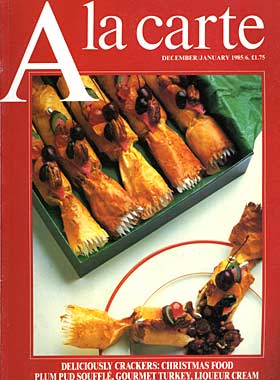
Rummaging around in my shed I came across a copy of ‘A La Carte’ magazine from Christmas 1985. In the 80s this title and ‘Taste’ magazine were the big foodie mags and I used to buy them in London to send to my Dad in Lancashire. My Dad loved cooking and had discovered this hobby relatively late in life. He was a cookery book cook and if what he made didn’t look exactly like the picture in the book he considered his efforts a failure. Thankfully food has become a bit more relaxed since then both in preparation and presentation.
Travelling back up north for the festivities, by the time I reached home he would often have saved a job for me to do that for some miguided reason he thought I would relish, usually on the display front. I remember one year he had made a salmon mouse in the shape of a leaping fish which he asked me to complete by surrounding it with dyed aspic. Unfortunately he had been a bit too heavy handed with the blue dye so it looked to be leaping in a municipal swimming pool. Another time he had saved me the job of tying smoked salmon and cream cheese parcels using chives as if they were ribbons – what I learnt from the experience; chives don’t behave like ribbon and do not like to be tied into bows.
Christmas cooking was always accompanied by much huffing, puffing and sighing, swearing under your breath and saying ‘never again’ (until the next time). How ever stressful and seemingly unpleasant those occasions were at the time they are the things I now remember most fondly especially as he’s not here any more to plan these mad meals.
This copy of ‘A La Carte’ was particularly special to us. A feature called ‘Surprise Christmas, it’s all wrapped up!’ was at the time inspired. I now see that Nigel Slater produced the feature (yes I know, that’s what I was thinking, I didn’t know he’d been around that long either!).

All the recipes made food that was gift wrapped. The filo pastry crackers, fabulously innovative at the time, were then copied by other magazines for the next 15 years at least. Me and Dad made them and found a box lined with tissue paper to serve them in.
But my absolute favourite recipe was for chocolate and praline boxes. The chocolate squares you needed to make the boxes weren’t easy to find even then. We had some old family friends over from Australia dining with us and when these little chocolate boxes were served they insisted on being photographed with them.
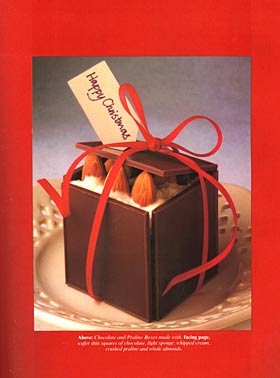
Here is the recipe. I hope nobody complains about the copyright – it’s Christmas after all and this is in the form of a homage.
Oh and by the way, I managed to buy the chocolate squares last week from an online sweet shop here. I’m going to make the chocolate and praline boxes again as a tribute to my Dad.
CELEBRATING THE SEASON
Monday December 17th 2007, 3:28 pm

I have come to the conclusion that foodie gifts are always welcome. Apart from gifts for children of course who generally prefer a Play Station to a bottle of extra virgin olive oil. This week I’ve got big plans for making gifts I know I’d love to be given.
NOT JUST FOR CHRISTMAS
Monday December 10th 2007, 1:03 pm
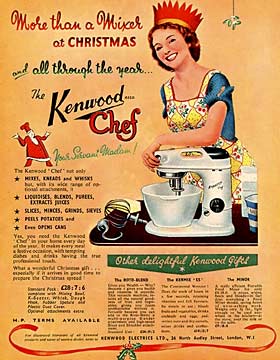
When it comes to food mixers there seem to be two main camps; do you choose Kenwood or Kitchenaid? The other day I realised that I was longing for a new Kitchenaid Artisan mixer (perhaps in tangerine) but my reasons were based on having seen them used on TV food programmes (always in red). As I consider myself intelligent enough to see through this blatant product placement I decided to question my desires. Both makes have been around for a very long time, Kenwood since the 50’s and Kitchenaid since before that and it seems that both have built up strong brand loyalty. I haven’t inherited a preference myself, growing up it was only the ‘Blackpool landlady’ faction of my family who aspired to the Kenwood Chef with all the attachments.
After some research I am drawn more towards Kenwood, originally and for most of its existence a British company. The design of the Chef stayed relatively unchanged from the early 60’s and has a great retro look, a bit more edgey than the US 50’s-diner style Kitchenaid. The fact that the Chef was considered to be ‘over engineered’ contributed to its robust and reliable reputation. So instead of rushing off to John Lewis to buy new I have saved a deserving vintage Chef from landfill. Christmas has come early at The Laundry and my life has just taken a turn for the better.
And not only that ….. it is TANGERINE.
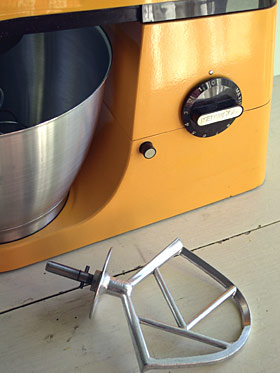
A SHOPKEEPER’S CRATE
Friday December 07th 2007, 3:26 pm
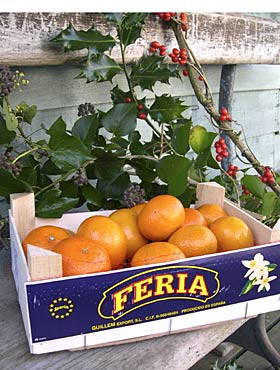
Shopping at Lidls can be an interesting challenge, finding little gems amongst the shelf loads of run-of-the-mill cheap produce with hardly a recognisable brand in sight to help you get your bearings. You definitely need glasses handy to check the multi-lingual lists of ingredients.
But sometimes special things are right under your nose. They are currently selling these dinky little shopkeeper’s crates of clementines which are sweet enough to use as part of your Christmas decorations. If you have any fruits left, Nigella does a squidgy clementine cake here which is worth a go and I have heard glowing reports about it.
NOT LONG NOW
Friday November 30th 2007, 1:54 pm
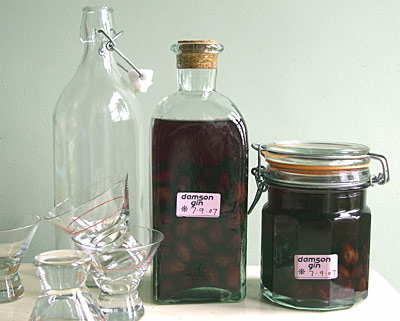
I had my house for some years before coming to live here and last Christmas was my first residing here full-time. I discovered a bottle of sloe gin tucked at the back of a cupboard. The pricked sloes had been left to steep in gin 6 or 7 years before and not being a great drinker I had forgotten the bottle was there. After pouring it through a coffee filter and rebottling, the liquid positively glistened and the taste was sublime. So this year I made a special effort to make some more but using damsons instead of sloes. Getting round to these things might be difficult at the time but the pay off later is certainly worth it.
So now here we are with Christmas only weeks away, the damson gin is nearly ready and the Christmas cake, made a few weeks ago, is calling out to be plied with brandy. I’ve completely forgotten the stress of getting these jobs done and now only have the promise of the results to look forward too.

ABOUT AS MUCH USE AS A CHOCOLATE IRON
Thursday November 22nd 2007, 10:05 am

A COOL IRON
A while back I found a rare 50’s vintage chocolate mould in the shape of an iron. It has been on my mantelpiece ever since but with Christmas coming and this being the season of chocolate-shaped novelties I decided to give the mould a dusting down and make some ‘cool irons’. The drawback is that with only one mould I can only make one iron at a time which then has to be left till completely set before being released.
As luck will have it, I contacted Julia Morgan from the British Iron Collectors Club who by some miracle also has one of these moulds in her extensive iron and laundry related collection which she has been prepared to lend me. OK, still not exactly a production line but output has now been increased by 100 percent!
I have got a few other really lovely vintage chocolate moulds for sale which will soon be added to The Laundry’s vintage pages. Will keep you posted.
